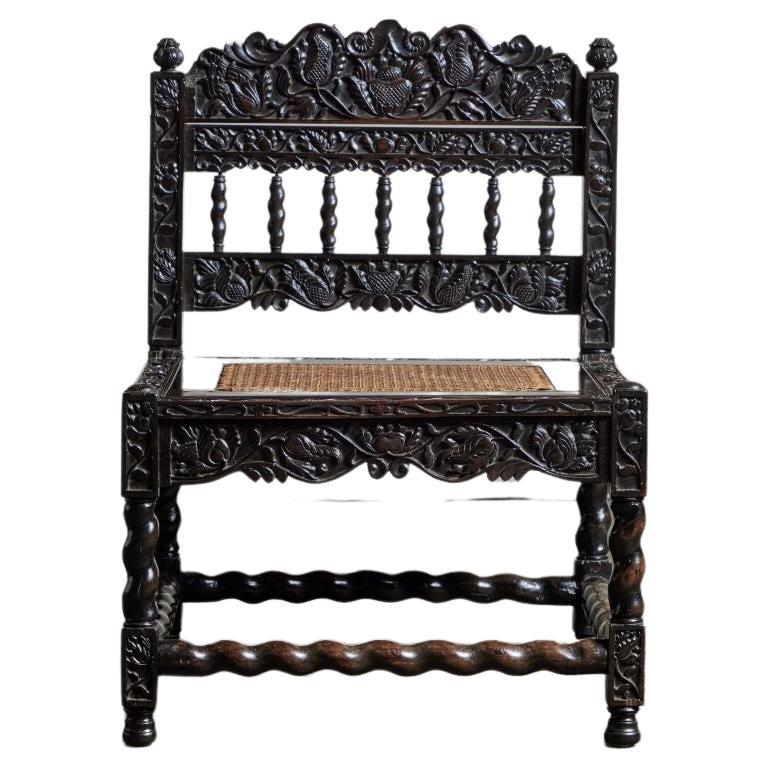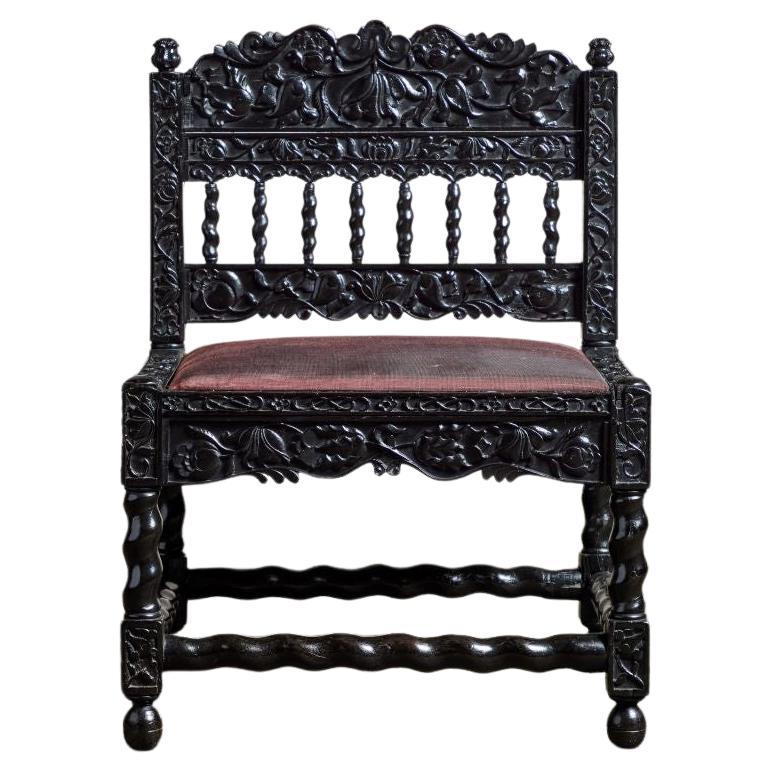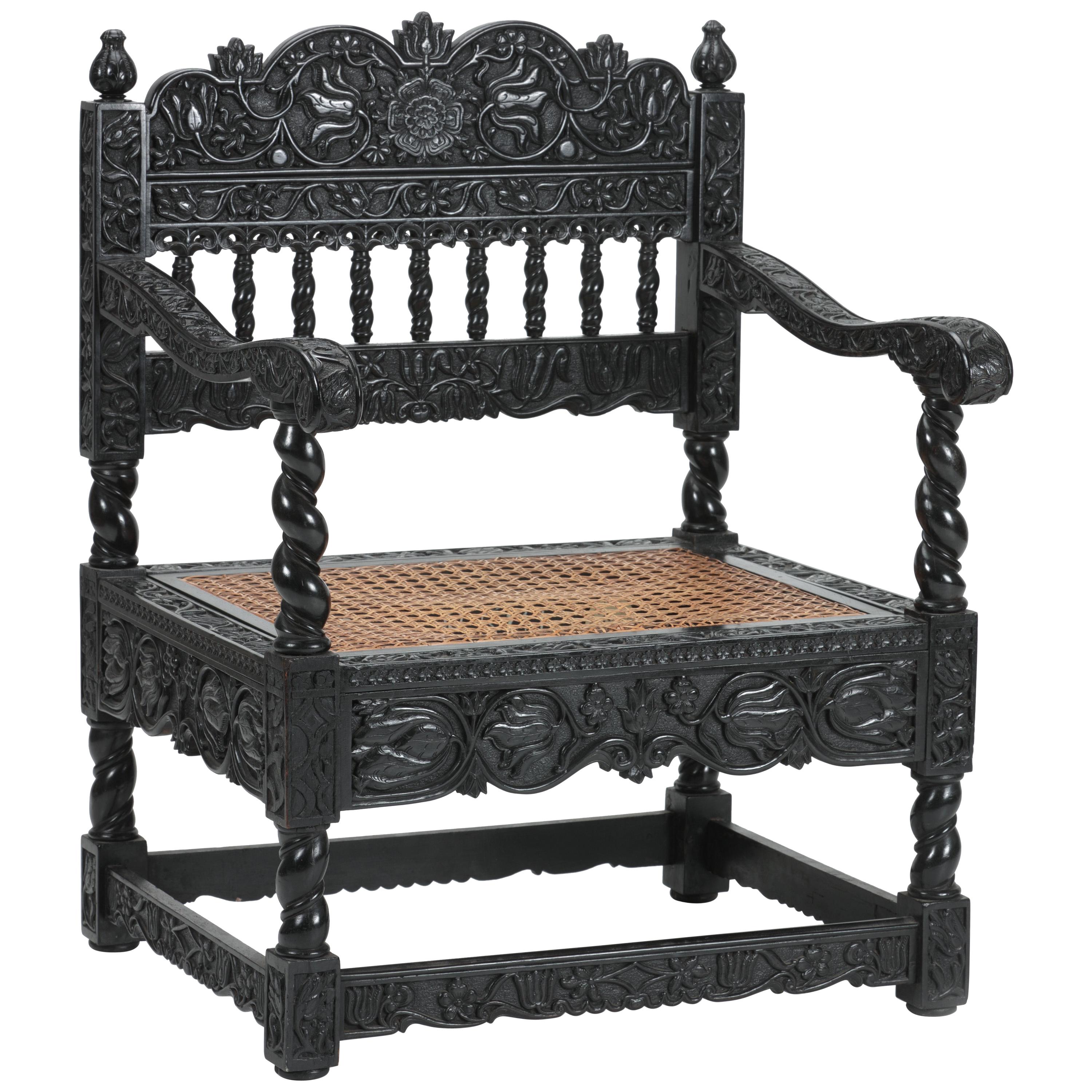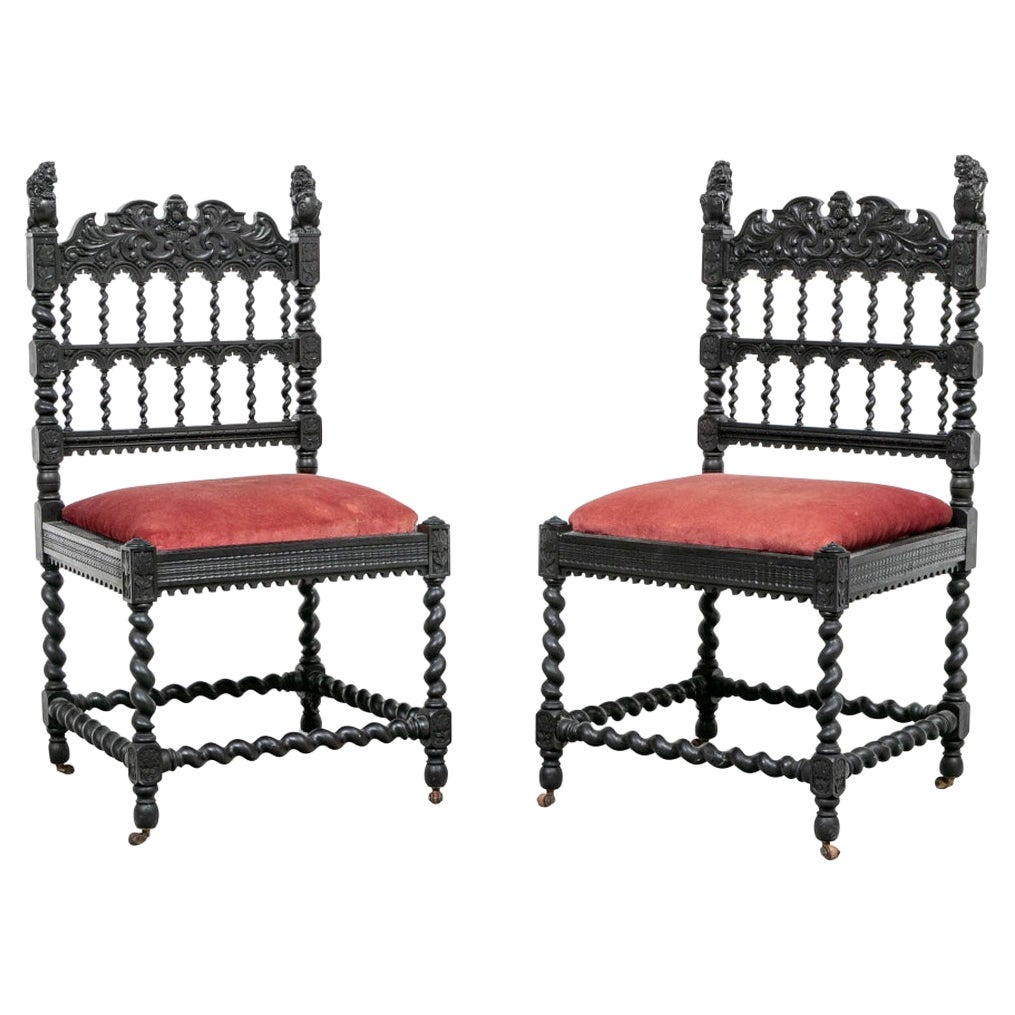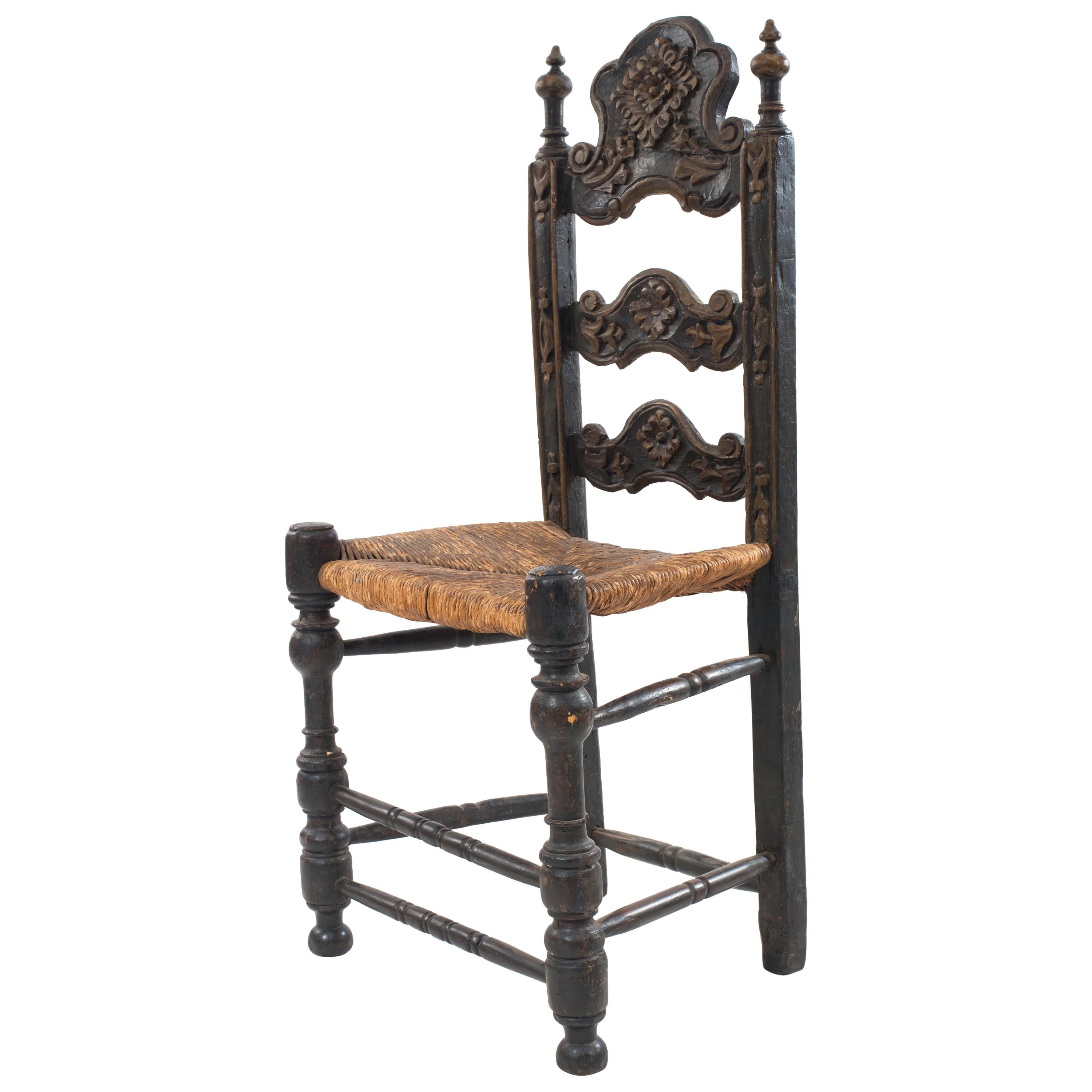Items Similar to 17th Cent. Dutch Colonial Ebony Chair Formerly Owned by the Duke of Westminster
Want more images or videos?
Request additional images or videos from the seller
1 of 5
17th Cent. Dutch Colonial Ebony Chair Formerly Owned by the Duke of Westminster
About the Item
An Indian ebony low chair formerly owned by the Duke of Westminster
Coromandel coast, possibly Madras, 1680-1700
Overall densely carved with an array of mermaids, birds, fish, mythological figures and floral and vine motifs, the back-rails are centered by a parrot (the attribute of Kama, the Hindu god of love) below a scallop shell (an attribute of Aphrodite/Venus) with a fleur-de-lis (a symbol of the Virgin Mary), the shell supported by two small human figures and a pair of mermaids, another Western element, but also a representation of the Hindu snake goddess Nagini, with crouching figures as finials, reminiscent of deity figures, with cane seatings.
H. 85 x W. 50.5 x D. 45 cm
Height of seat 41.5 cm
Note:
An identical chair is illustrated in Het Hollandsche Koloniale Barokmeubel, Dr. V. I. van de Wall, .1939, fig. 26. The Provenance of that chair is given as the Duke of Westminster, Eaton Hall, Chester. Before restoration the present pair had identical upholstered seats and the same casters as the chair of the Duke of Westminster. Therefore it seems safe to assume that the provenance of the present pair also is the Duke of Westminster, Eaton Hall in Chester. In the seat rails of the present chairs both are numbered II and III respectively, so they probably once belonged to a larger set in Eaton Hall. This type of chair usually turns up in England and seldom in Holland although they were also ordered by the Dutch on the Coromandel Coast of India. Possibly the Hindu motives of animals and humans in the carvings of these “Kust stoelen” were eventually not greatly appreciated in Muslin/Calvinist Java/Batavia. These high points in ebony furniture making were made by Hindu craftsmen in South India converted to Roman Catholicism by the Portuguese in the 16th and 17th centuries. These furniture makers, with their origins in the Hindu world, combined Hindu and Christian motives in a manner which was not seen again in furniture from India after the 17th century.
As in other known examples, the carving is in the round. The carvings on these two chairs bear a close resemblance to the carving of the head- and foot-boards of the ebony rocking cradle in the Rijksmuseum Amsterdam (BK-1966-48, illustrated in: Asia in Amsterdam, 2015, cat. 26, p.108).
- Dimensions:Height: 33.47 in (85 cm)Width: 19.89 in (50.5 cm)Depth: 17.72 in (45 cm)Seat Height: 16.34 in (41.5 cm)
- Style:Dutch Colonial (Of the Period)
- Materials and Techniques:
- Place of Origin:
- Period:Late 17th Century
- Date of Manufacture:1680-1700
- Condition:Wear consistent with age and use.
- Seller Location:Amsterdam, NL
- Reference Number:1stDibs: LU5458220859742
About the Seller
5.0
Vetted Seller
These experienced sellers undergo a comprehensive evaluation by our team of in-house experts.
Established in 1985
1stDibs seller since 2020
19 sales on 1stDibs
Typical response time: 3 hours
- ShippingRetrieving quote...Ships From: Amsterdam, Netherlands
- Return PolicyA return for this item may be initiated within 7 days of delivery.
More From This SellerView All
- Dutch Colonial 17th Century Ebony Armchair, India/Indonesia/Sri LankaLocated in Amsterdam, NLAn unusual Indian half-relief carved ebony armchair Coromandel coast, 1680-1700 ? Throughout carved with floral and vine motifs, the back rail with a central peony and ...Category
Antique Late 17th Century Indian Dutch Colonial Furniture
MaterialsRattan, Ebony
- Dutch Colonial 17th Century Ebony Center Table with Marble TopLocated in Amsterdam, NLAn Indonesian ebony centre table with marble top Jakarta (Batavia) or Coromandel coast, 1650-1680 With shallow carvings of flowers and vi...Category
Antique Mid-17th Century Indian Dutch Colonial Furniture
MaterialsMarble
- A Dutch Colonial 17th century Red Ebony Center table with marble topLocated in Amsterdam, NLA MOLUCCAN RED EBONY CENTRE TABLE WITH MARBLE TOP The Moluccas/Ambon, third quarter 17th century Carved in low-relief with decoration of plant...Category
Antique Late 17th Century Indian Dutch Colonial Furniture
MaterialsMarble
- A 17th century Dutch-colonial ebony two-door VOC cabinet with silver mountsLocated in Amsterdam, NLA Dutch-colonial ebony two-door cabinet with silver mounts Coromandel Coast, probably Masulipatnam, circa 1650-1680, the silver later H. 64.5 x W. 75 x D. 46 cm The present cabinet...Category
Antique 17th Century Indian Dutch Colonial Antiquities
MaterialsSilver
- Dutch Colonial Indonesian Hardwood Four Chair-Back Settee, Late 17th CenturyLocated in Amsterdam, NLAn Indonesian Javanese rosewood (sono keeling) four chair-back settee Java, probably Jakarta (Batavia), late 17th century The massive bench on ten turned connected legs, with four back-splats with cane. Measures: H. 108 x W. 216 x D. 71 cm Seat height approx. 48 cm Note: Batavian chairs and settees of this type were based on the medallion caneback chairs...Category
Antique Early 18th Century Indonesian Dutch Colonial Furniture
MaterialsCane, Hardwood
- Dutch Colonial Silver Dish with the Von Pfeffel Coat-of-arms, 17th CenturyLocated in Amsterdam, NLAn unusual Indonesian lobbed silver dish Jakarta (Batavia) or Coromandel coast, third quarter 17th century, apparently unmarked The eight lobbed dish exuberantly decorated with floral motifs, with the middle section replaced, consisting of indistinctly marked German silver from the early 19th century, bearing the coat-of-arms of the Von Pfeffel family. Diam. 30.5 cm Weight 461 grams Note: Lobbed silver dishes with exuberant floral decorations were characteristic of the decorative arts in the Netherlands in the first half of the 17th century. This style of floral decoration was adopted by silversmiths as well as by furniture makers working on the Coromandel Coast and in Batavia, often by workers who had fled the Coromandel Coast because of war and famine. In Batavia this style was known as “Custwerck” (work from the Bengal coast). These lobbed dishes are seldom marked. Only after 1667 the use of the town mark became obligatory in Batavia but only for silver made in Batavia not for silver imported in Batavia from other VOC settlements. The engraved coat of arms in the centre is a replacement of the original centre. The coat of arms can be identified as those of Christian Hubert von Pfeffel (1765- 1834). As a diplomat, statesman, ambassador of Bavaria in London and Saxony and councillor to the King of Bavaria, he was made “Freiherr” in 1828 and since then used this coat of arms. His son Karl Maximilian Friederich Hubert Freiherr von Pfeffel (1811-1890) in 1836 married Karoline Adelheid Pauline von Rottenburg (1805-1872), the natural daughter of Prins Paul von Württemberg (1785-1852) and his mistress Margrethe Porth. Paul was the jounger brother of the King Wilhelm I of Württemberg (1781-1864). The heraldic motto of the von Pfeffels Vur Schande habe den Huot means as much as “Beware of Shame”. Christian Hubert Theodoor Marie Karl von Pfeffel Karl Maximilian’s grandson was the last male in the von Pfeffel line. His daughter, Marie Louise (Paris in 1882 - Cornwall 1944), born and grown-up in France, changed her name in de Pfeffel. She was the great grandmother of Boris Alexander de Pfeffel Johnson, the present British Secretary of State. None of the members of the von Pfeffel family had any direct links with the Dutch East Indies but indirectly by way of the Royal House of Württemberg they did. Sophia Frederika Mathilda von Württemberg (1818-1877), daughter of Wilhelm I King of Württemberg, in 1839 married Willem III...Category
Antique Late 17th Century Indonesian Dutch Colonial Sterling Silver
MaterialsSilver
You May Also Like
- 17th Century Dutch Colonial Ebony Side ChairLocated in Pasadena, CADutch Colonial Ebony side chairs from the late 17th/early 18th century.Category
Antique Early 17th Century Dutch Side Chairs
MaterialsWood
- 17th Century Dutch Colonial Ebony Side ChairLocated in Pasadena, CADutch Colonial Ebony side chairs from the late 17th/Early 18th Century.Category
Antique Late 17th Century Dutch Side Chairs
MaterialsWood
- Rare and Important Pair of Dutch Colonial Carved Side ChairsLocated in Bridgeport, CTThe ebonized chairs with shaped and carved crest rails with leaves and center fruit basket motifs. The barley twist side supports with carved flower...Category
Antique 19th Century Dutch Colonial Side Chairs
MaterialsEbony
- Pair of Dutch Colonial Plantation Chairs from Java, Indonesia c. 1900Located in Jimbaran, BaliAn elegant pair of early 20th Century Dutch colonial chairs with cane seats from Java, Indonesia. Their curved legs, and age related patina of the wood adds to their charm.Category
Early 20th Century Indonesian Dutch Colonial Chairs
MaterialsCane, Wood
- 3 Italian Renaissance style (17th Cent) green and gold painted & carved ladder bLocated in New York, NY3 Italian Renaissance style (17th Cent) green and gold painted & carved ladder back high back side chairs with rush seat. (PRICED EACH)Category
Antique 17th Century Italian Renaissance Side Chairs
MaterialsRush, Wood
- Pair of 17th Century English Oak Side ChairsLocated in Gloucestershire, GBA rare pair of 17th century English oak side chairs having high backs, beautifully carved top rails and wide panelled back splats flanked by tur...Category
Antique 17th Century Side Chairs
MaterialsOak
Recently Viewed
View AllMore Ways To Browse
Furniture From India
Antique Ebony Furniture
Ebony Antique Furniture
Antique Furniture From India
Before Restoration
Dutch 17th
Dutch Carved
Pair Colonial
Pair Of Colonial
Dutch Floral
17th Century Dutch Furniture
Dutch Turn Of The Century
Dutch Bird
Colonial India
Dutch Furniture Maker
Colonial Seat
Colonial Dutch
Dutch Motif
